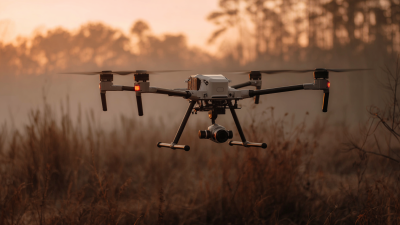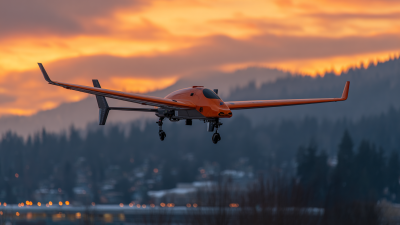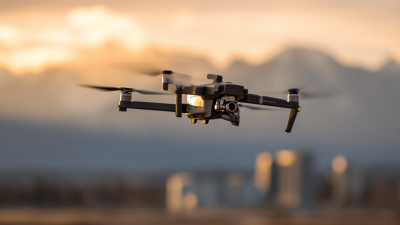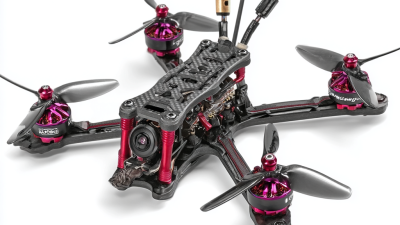Leave Your Message
The emergence of Long Endurance UAV Drones is set to revolutionize various sectors, particularly aerial surveillance and delivery. According to a report by Research and Markets, the global UAV market is expected to reach USD 58.4 billion by 2026, with a significant portion attributed to long endurance models that enable extended operational capabilities. These drones can fly for over 24 hours non-stop, providing invaluable support for military surveillance, disaster monitoring, and delivery services, catering to the growing demand for efficient and reliable logistics solutions. As industries increasingly adopt advanced aerial solutions, the integration of digital technologies with Long Endurance UAV Drones is not just a trend but a paradigm shift, anticipated to enhance situational awareness and streamline supply chains across the globe.

Long endurance UAV drones represent a significant leap forward in aerial surveillance capabilities, allowing for extended flight periods that greatly enhance mission effectiveness. One of the most compelling characteristics of these drones is their ability to remain aloft for hours or even days, making them ideal for persistent observation over vast areas. This prolonged endurance enables operators to gather comprehensive data on real-time activities, which is essential for applications ranging from border patrol to wildlife monitoring.
Another key feature of long endurance UAVs is their advanced payload capacity. Equipped with high-resolution cameras, thermal imaging sensors, and communication systems, these drones can capture detailed imagery and relay critical information back to command centers. The integration of AI and machine learning algorithms also empowers these drones to analyze the data collected, identifying patterns and potential threats without human intervention. Collectively, these characteristics not only enhance situational awareness but also allow for quicker decision-making in diverse scenarios, effectively revolutionizing how surveillance missions are conducted.
This bar chart illustrates the key characteristics of long endurance UAV drones that enhance their suitability for aerial surveillance tasks. The data points represent various features rated on a scale from 0 to 100, indicating their effectiveness.
The landscape of Unmanned Aerial Vehicles (UAVs) is experiencing a seismic shift, propelled by technological innovations that are redefining capabilities in aerial surveillance and delivery. The recent unveiling of advanced UAV platforms showcases the relentless progress in drone technology, emphasizing features that enhance adaptability and efficiency. These innovations are not merely about improving existing models; they represent a leap toward autonomous systems that can operate in various challenging environments. This transformation is not limited to military applications; industries across North America are beginning to harness UAVs for logistics, agriculture, and emergency response, demonstrating a growing reliance on drone technology.
Tips: When considering the integration of UAVs into your operations, focus on understanding the specific applications that will provide the greatest return on investment. Additionally, keep an eye on the regulatory landscape as it evolves; knowing the legal requirements is essential for successful implementation.
Moreover, as nations strive for self-reliance in defense, breakthroughs in AI, UAVs, and autonomous warfare technologies are becoming imperative. Countries like India are expanding their defense capabilities, aiming to minimize dependency on imports. Meanwhile, emerging markets in Africa are testing drone technologies that could transform internet connectivity and disaster response. This global shift indicates that the potential of UAVs extends far beyond traditional applications, driving a transformation in how societies interact with technology.
Tips: Exploring partnerships with technology providers can accelerate the adoption of UAV innovations in your field. Stay informed about emerging trends, as they can offer insights into future developments and opportunities.
 Unmanned Aerial Vehicles (UAVs) have emerged as a transformative technology in aerial surveillance and delivery systems, offering several comparative advantages over traditional methods. One of the most significant benefits is the ability to operate without risking human life. In dangerous environments where traditional aircraft would be compromised, UAVs can perform reconnaissance and gather intelligence safely. Additionally, their ability to remain airborne for extended periods allows for continuous monitoring of vast areas, making them ideal for border security, wildlife tracking, and disaster response efforts.
Unmanned Aerial Vehicles (UAVs) have emerged as a transformative technology in aerial surveillance and delivery systems, offering several comparative advantages over traditional methods. One of the most significant benefits is the ability to operate without risking human life. In dangerous environments where traditional aircraft would be compromised, UAVs can perform reconnaissance and gather intelligence safely. Additionally, their ability to remain airborne for extended periods allows for continuous monitoring of vast areas, making them ideal for border security, wildlife tracking, and disaster response efforts.
Moreover, UAVs are equipped with advanced sensors and cameras that surpass the capabilities of conventional aerial platforms. Their high-resolution imaging and real-time data transmission enable rapid decision-making and adaptive responses to dynamic situations. The cost-effectiveness of deploying UAVs further enhances their appeal, as they require less maintenance and operational expenditure compared to manned aircraft. This technological shift not only elevates the efficiency of aerial surveillance but also opens new avenues for applications in logistics and delivery systems, transforming how goods and services are transported and monitored.
The implementation of long endurance UAV drones for delivery presents several significant challenges that must be addressed to ensure effectiveness and reliability. One major issue is battery life and energy efficiency, which are critical for extended flight times. Current battery technologies often limit the range and payload capacity of these drones, necessitating the exploration of alternative energy sources, such as solar power or fuel cells, to enhance operational longevity. Furthermore, optimizing flight paths for efficiency can mitigate energy consumption, allowing drones to cover larger distances with minimal resource expenditure.

Another challenge lies in regulatory compliance and airspace management. As UAV usage increases, so does the necessity for robust frameworks governing their operation to ensure safety and minimize air traffic congestion. Collaborative approaches involving regulatory bodies, manufacturers, and industry stakeholders are essential to devise comprehensive policies that facilitate the integration of long endurance drones into existing airspace systems. Additionally, advances in automated systems and AI can help streamline navigation and collision avoidance, creating safer environments for both UAVs and manned aircraft. Solving these challenges will be pivotal for harnessing the full potential of long endurance UAV technology in the delivery sector.
Long endurance UAV drones are poised to transform various industries by enhancing operational capabilities and providing innovative solutions. In agriculture, these drones can monitor crop health over vast areas, analyze soil conditions, and even deliver supplies to remote fields. The ability to cover large distances without frequent recharging can streamline processes and reduce costs significantly. In logistics, long endurance UAVs can revolutionize last-mile delivery, making it feasible to reach underserved regions with speed and efficiency, thus improving service delivery.
Tips: When considering the integration of long endurance UAVs into your operations, ensure you assess the regulatory environment regarding drone usage in your area. Collaborating with local authorities can facilitate smoother implementation and compliance with necessary guidelines.
Moreover, in the realm of disaster management, these drones can be deployed for real-time surveillance and assessment of affected areas. Their extended flight times allow for continuous monitoring, which is crucial during emergencies. They can assist in locating victims, delivering medical supplies, and contributing to recovery efforts. As industries increasingly adopt these technologies, the potential for innovation will only expand, leading to groundbreaking applications across sectors.
Tips: Stay updated on advancements in UAV technology and consider investing in training sessions for your team to maximize the benefits of long endurance drones in your operations.






